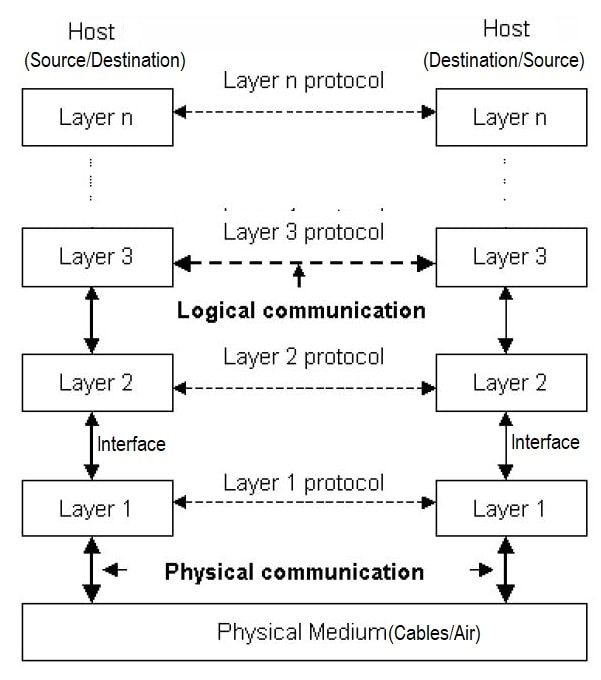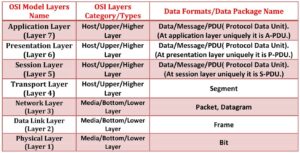Introduction of Networking Model
- Most of the computer networks today are organized as a series of layers arranged as a stack one upon another.
- The layering of network model is done in order to divide the workload or division of labour and also to simplify the system design.
- The functionality of this layered structure differs from network to network. However, regardless of the differences among all networks, the purpose of each layer is to provide certain services to the layer located above it, and thus shielding the upper layers from the complicated details of how the services offered are implemented.
- A logical communication may exist between any two computers through the layers of the same ‘level’ i.e. Layer – n on one computer may converse with layer-n on another computer.
- There are rules and conventions used in the communication at any given layers, which are known collectively as the layer-n protocol for the nth layer.
- In a computer network, data are not directly transferred from layer-n on one computer(source) to layer-n on another computer(destination). Rather, each layer passes sender’s data and control information to the layer directly below until the lowest layer is reached. Below layer-1 (the bottom layer), is the physical medium/channel (the hardware) through which the actual transaction takes place. On the other hand, receiver receives data from physical medium to top layer passing each layer.
- Interface : Between every pair of adjacent layers there is an interface. The interface is a specification that determines how the data should be passed between the layers. It defines what primitive operations and services the lower layer should offer to the upper layer. This interface structure between the layers are one of the most important considerations when designing a network. To create such an interface between the layers would require each layer to perform a specific collection of well-understood functions. A clean-cut interface makes it easier to replace the implementation of one layer with another implementation because all that is required of the new implementation is that, it offers, exactly the same set of services to its neighbouring layer above as the old implementation did.

Types of Networking Model
There are two famous working & successful world class and the most popular networking models –
[A] OSI Reference Model [B] TCP/IP Reference Model
[A] OSI Reference Model
History
- In 1983, the International Standards Organization (ISO) developed a model called Open Systems Interconnection (OSI).
Introduction
- To send/receive and understand information in a computer network successfully, there exist a set of rules(TCP/IP) or standards (OSI) where standards ensure that varying devices and products can communicate with each other over any network. This set of standards is called a network reference model.
- There are a variety of networked models currently being implemented but OSI and TCP/IP models are important ones.
Definition
- The Open System Interconnection (OSI) model is a network reference model which contains a set of protocols in their layered architecture that attempts to define and standardize(how data communications should take place) the data communications process in a network environment.
- The OSI (Open Systems Interconnection) model is a conceptual framework that standardizes the functions of a communication system into seven distinct layers.
- It is a standard reference model for OSI communication between two end users in a network.
Features
- Each layer of the OSI reference model is responsible for a particular aspect of data communication.
- Each layer has a set of specific functions that are to be performed by a specific protocol(s).
- The OSI model is modular i.e. each successive layer of the OSI model works with the one above and below it.
- This model actually describes how information from a software application in one computer moves through a network medium to a software application in another computer.
- The OSI reference model has a protocol suit for all of its layers.
- This model is considered as the primary architectural model for inter-computer communications.
- The OSI model has the support of most major computer and network vendors, many large customers, and most governments in different countries.
- The model is used in developing and TCP/IP Models products and understanding networks.
- This model is a prescription of characterizing and standardizing the functions of a communications system in terms of abstraction layers.
- Here, similar communication functions are grouped into logical layers.
- The OSI model divides the tasks involved with moving information between networked computers into seven smaller, more manageable task groups. A task or group of tasks is then assigned to each of the seven OSI layers.
- Each layer of this model is reasonably self-contained hence the tasks assigned to each layer can be implemented independently. This enables the solutions offered by one layer to be updated without affecting the other layers.
- Each layer of this model, except the physical layer, adds few extra necessary information to the data as it travels from the Application layer down to the physical layer. This extra information is called Control Information in the header part of the transmitting unit. The physical layer does not append any information into header because it is concerned with sending and receiving information on the individual bit level. Here, we see that the data for each layer consists of the header part and data part of the next higher layer. Because the data format is different at each layer, so different terms for data part are commonly used to name the data package at each level.
Types of OSI Reference Models
(A) Although, each layer of the OSI model provides its own set of functions but it is possible to group the layers into two major distinct categories :-
(a) The Host/Upper Layers :
-
- This layer includes Application layer, Presentation layer, Session layer and Transport layer.
- This layer focuses on user’s applications and how applications/ files are represented on the computers prior to send.
(b) The Media/Lower Layers :
-
- This layer includes Network layer, Data Link layer and Physical layer.
- The layer focuses on how the communication across a network actually occurs.
(B) The OSI reference model is further divided into two major category on the basis of data delivery –
(a) Data Processing Oriented Layers :
-
- The top three layers i.e., the application, presentation, and session layers provide the application services required for the exchange of information.
- They allow two applications, each running on a different node/machine of the network to interact with each other through the services provided by their respective operating systems.
(b) Communication Oriented Layers :
-
- The first four layers i.e., physical, data link, network, and transport layer provide the end-to-end services necessary for the transfer of data between two systems.
- These layers provide the protocols associated with the communications network used to link two computers together.
(C) The OSI reference model is a conceptual model composed of seven layers as shown below and each layer specifying particular network functions.
(i) Physical Layer (Layer 1)
(ii) Data Link Layer (Layer 2)
(iii) Network Layer (Layer 3)
(iv) Transport Layer (Layer 4)
(v) Session Layer (Layer 5)
(vi) Presentation Layer (Layer 6)
(vii) Application Layer (Layer 7)

0 Comments